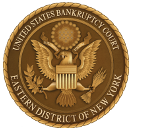You are here
Frequently Asked Questions
-
What should I do if the ECF system is not available?
If you are trying to access ECF and cannot get in, please contact our ECF HelpDesk immediately to report the problem. It is important to note the date, exact time of the day and nature of the problem. The clerk's office maintains a log of ECF downtime. Deeming the filing of a document or paper to be timely under such circumstances will be a judicial function of the court. If you wish, you may file the document with the court on disk.
-
How do I select events/reliefs when filing a multi-relief motion?
Use the control key and the mouse to select all applicable forms of relief from the Available Events list in CM/ECF. The system then processes each of the motion parts, one at a time, leading the filer through the steps necessary to complete each part.
-
If I file electronically, what are my responsibilities regarding the original document?
Filers must maintain the original document for two years after the entry of a final order terminating the case or proceeding to which the document relates.
-
Is there a limit to the size of a document that can be filed?
The limit is 4 megabytes (4000k). If you have a document larger than 4 megabytes, you will not be able to upload that document to the system. You must separate the document into files that are no greater than 4 megabytes. The file size limit applies to each document or attachment, not to all of the documents combined in one filing.
-
Will docket entries be identified as to who entered them?
Yes, all attorney entries are identified by the name of the person that logged in and submitted the entry. At the end of each attorney entry, the filer will be listed as (last name, first name).
-
Is there any way for pro se filers or attorneys without Internet access to file documents?
Yes. An attorney with a computer (Windows or Macintosh) that can save documents in PDF (portable document format) can save the documents on a computer diskette or CD-Rom and file either with the court. The system also can accept paper filings from pro se filers. In such instances, the court would convert the paper to electronic format by scanning, and then add the scanned image into the ECF system. The court does not accept paper filings from attorneys in any ECF case.
-
What’s the difference between an ECF case and a non-ECF case?
ECF became the primary method for filing documents with the court in Chapter 11 cases and associated adversary proceedings commenced as of April 1, 2002, and for all other cases and associated proceedings commenced as of January 1, 2003. The first ECF Chapter 11 case in Central Islip was case no. 02-82151; in Brooklyn, the first ECF Chapter 11 case was case no. 02-14048. All cases prior to these dates require documents to be filed on paper.
-
How do you obtain a Discharge in an Individual Chapter 11 Case?
Effective immediately, an individual seeking a discharge in a Chapter 11 case is required to file an application for a discharge with a certification that all payments have been made in accordance with the confirmed Chapter 11 plan. Notice of the application shall be served on all creditors and the United States Trustee.
